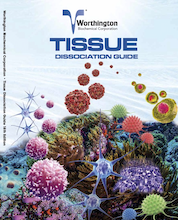For our international customers, please be advised that orders cannot be placed through our website by customers in countries with International Distributor representation.
Worthington Tissue Dissociation Guide
Dissociating Enzymes: Trypsin
Trypsin is a pancreatic serine protease with a specificity for peptide bonds involving the carboxyl group of the basic amino acids, arginine and lysine. Trypsin is one of the most highly specific proteases known, although it also exhibits some esterase and amidase activity.
Purified trypsin alone is usually ineffective for tissue dissociation since it shows little selectivity for extracellular proteins. Combinations of purified trypsin and other enzymes such as elastase and/or collagenase have proven effective for dissociation.
"Trypsin" is also the name commercial suppliers have given to pancreatin, a crude mixture of proteases, polysaccharidases, nucleases and lipases extracted from porcine pancreas. NF 1:250, a commonly used "trypsin" preparation, has the potency to bring about the proteolytic digestion of 250 times its weight of casein under assay conditions specified by the National Formulary. It is important to realize that this assay procedure is not specific for trypsin, although pancreatin does contain this enzyme. Nomenclature notwithstanding, crude "trypsins" like NF 1:250 and 1:300 are widely used for dissociating tissues, perhaps because the tryptic and contaminating proteolytic and polysaccharidase activities do bring about a preferential attack of the extracellular matrix. It appears, however, that crude trypsin and crude collagenase dissociate tissues by different mechanisms, and difficulties are often encountered when using NF 1:250 preparations -- the most common being incomplete solubility, lot-to-lot variability, cell toxicity, and cell surface protein/receptor damage.
In tissue culture laboratories, researchers use purified trypsin to release cells into suspension from monolayers growing on the interior surfaces of culture vessels. Most cells originating from normal tissues and not highly adapted to artificial culture conditions grow in monolayers, i.e., a layer of cells one cell thick adhering to the interior surface of the culture vessel. Because such cells are more like cells in normal tissues, many tissue culture researchers are studying cells that grow in monolayer culture.
Monolayer cultures are commonly grown in glass or polystyrene roller bottles, culture flasks, or Petri dishes. Plastic vessels used in tissue culture work are specially treated to ensure good adherence of cells to the vessel walls. For a detailed discussion of cell harvesting, see page xv of this guide.
Some of the most frequently used grades of purified trypsin for cell isolation procedures are the Worthington product Codes: TL, TRL, TRLS, and TRLVMF. These products are suitable for cell harvesting as well as tissue dissociation.
Tissue Tables
The Worthington Tissue Tables provide references useful to researchers interested in tissue dissociation and cell harvesting procedures. The references are organized by Tissue and Species type and linked to PubMed citations. The Cell type, Enzymes, and Medium for each reference is provided.
To search by specific criteria, use the Tissue References Search Tool.
